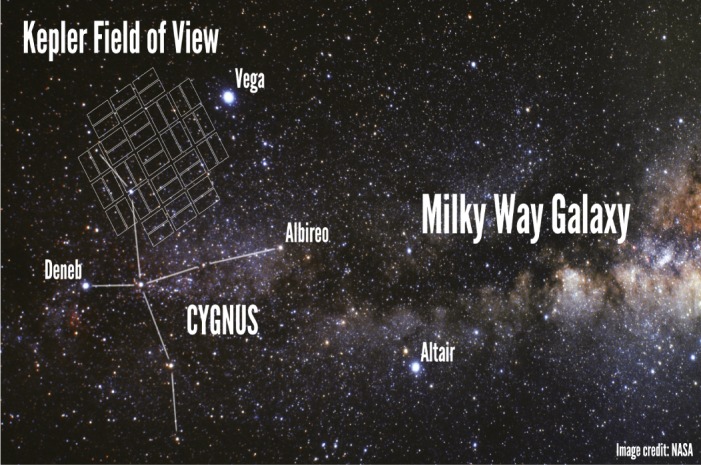Counting Earth-like planets

Field of view of the Kepler space telescope, located in the constellation Cygnus, just above the plane of the Milky Way Galaxy.
Many of the extrasolar planets discovered so far are gas giants that orbit close to their parent star. Rocky Earth-like planets are hard to spot, leading to uncertainty about how many Earth-like planets may exist. Erik Petigura et al. (pp. 19273–19278) used data from the Kepler space telescope to search for planets with radii one to two times that of Earth and receiving between one and four times the stellar irradiation received on Earth; stellar irradiation may determine whether water could exist as a liquid on these planets’ surfaces. The Kepler telescope monitored periodic dimming of stars, possibly indicative of planets in transit. Researchers previously combed through more than 42,000 stars and discovered 600 likely Earth-like planets, including 10 with radii and stellar irradiation similar to those of Earth. Correcting for planets that may not have been detected, the authors concluded that around 26% of Sun-like stars harbor Earth-size planets with orbital periods up to 100 days. Overall, 22% of Sun-like stars may be orbited by Earth-size planets receiving Earth-like levels of stellar energy, within the so-called habitable zone. According to the authors, models of planetary formation in which solids accumulate first in protoplanetary disks suggest that small, rocky planets may outnumber gas giants in the universe. — P.G.
Model may help evaluate potential alternatives to fracking
Comminution, a catchall term for fragmenting, crushing, and pulverizing solids, underlies efforts such as tunneling, mining, and the study of meteorite and missile impacts. Although research on fracturing in large rock masses has yielded numerous dynamic models, no studies have yet advanced a constitutive equation that would allow comminution modeling on large scale rock masses. Inspired by analogous processes in fluid dynamics, Zdeněk Bažant and Ferhun Caner (pp. 19291–19294) present a theoretical framework to address this need. Unlike quasi-static fracturing, which is driven by the release of strain energy accumulated in the rock mass, the authors’ model uses the kinetic energy of high-rate shear strain in the rock to drive high-rate fracturing, similar to how eddies dissipate energy in a turbulent flow. The concept stems from the authors’ observation that this kinetic energy, at sufficiently high strain rates, far exceeds the maximum possible accumulated strain energy, rendering the strain energy effectively irrelevant. The findings could influence recently proposed, environmentally friendly alternatives to hydraulic fracturing that would free methane from shale beds using borehole-associated shock waves, thus minimizing the discharge of chemically contaminated water, according to the authors. — T.J.
Revising the standards for statistical testing procedures

Stylized measurements of habanero varieties. Image courtesy of Pamela Johnson.
Nonreproducibility in scientific studies can hinder scientific progress and undermine public confidence in science. Valen Johnson (pp. 19313–19317) investigated whether part of the problem of non-reproducibility can be attributed simply to the routine use of widely accepted statistical testing procedures. The author examined the correspondence between the outcomes of two statistical hypothesis testing paradigms to gain insight into the amount of evidence required to reject a null hypothesis. The most common hypothesis testing approach, known as the classical paradigm, declares a finding as significant when the value of a test statistic exceeds a specified threshold; by long-standing convention, a significance level of 0.05 represents a significant finding. The second approach, known as the Bayesian paradigm, estimates the relative probability of a hypothesis based on the observed data and any available prior information about the variables involved, and compares hypotheses using Bayes factors. The author demonstrates that classical tests conducted at the 0.05 and 0.01 levels of significance correspond to modest Bayes factors of approximately 5 and 20, respectively. By contrast, significance levels of 0.005 and 0.001 correspond to Bayes factors of 25–50, which are considered strong evidence in favor of the alternative hypothesis, and 100–200, which are considered decisive evidence, respectively. According to the author, the findings suggest that commonly used thresholds for statistical significance represent only moderate evidence against null hypotheses. To improve the replicability of scientific research, the author suggests decreasing the default significance threshold from 0.05 to 0.005. — N.Z.
Genetic loci linked to bovine fertility
Over time, a preference for dairy cattle with the highest milk yields has spurred a decrease in cattle conception rates. To probe the underlying genetic basis of the decrease, Mayumi Sugimoto et al. (pp. 19495–19500) examined the genomes of 384 Holsteins, searching for genetic loci associated with fertility. A genome-wide association study revealed four genetic variants, including two in the gap junction-related genes PKP2 and CTTNBP2NL, and two in the neuroendocrine-related genes SETD6 and CACNB2. Gap junctions are structures composed of connexins that link the cytoplasm of two neighboring cells, enabling communication critical for cell growth and differentiation. Further analysis revealed that the PKP2 protein increased expression of a gap junction protein known as connexin 43, while CTTNBP2NL dephosphorylated the protein. Tweaking the expression of either gene—either repressing PKP2 or overexpressing CTTNBP2NL—interfered with embryo implantation. Investigation of the neuroendocrine-related genes revealed that SETD6 plays a role in the transcriptional regulation of gonadotropin-releasing hormone, whereas CACNB2 controls the secretion of follicle-stimulating hormone in cattle. According to the authors, the findings reveal important roles for gap junction communication and the neuroendocrine system in conception and could help inform strategies to improve reproductive performance in the livestock industry. — A.G.
Testosterone’s role in birdsong
Hormones such as testosterone can act on several areas of the brain to produce a behavioral response, such as birdsong. To determine how testosterone influences birdsong, Beau Alward et al. (pp. 19573–19578) exposed the brain of castrated canaries to testosterone. Some of these canaries received the hormone throughout their brains via a systemic treatment, while others received testosterone in a brain region known as medial preoptic nucleus, or POM. Both groups of birds began singing, but after a few days of song, the authors noticed that POM-implanted canaries sang poor quality songs. POM-implanted birds continued to show normal mating behavior in the presence of females, but did not sing, contrary to the behavior of birds receiving testosterone throughout their brains. The authors suggest that testosterone may act on several neural centers to produce the full repertoire of male behavior. Further, the POM-implanted canaries displayed growth in song-control regions of the brain, suggesting that singing stimulated the birds’ neuroplasticity in the absence of local testosterone, according to the authors. — P.G.
Transmission of a neurodegenerative disorder from humans to mice

α-Synuclein deposits in the brainstems of inoculated mice.
The neurodegenerative disorder known as multiple system atrophy (MSA) is a variant of Parkinson disease (PD) and is characterized by the accumulation of misfolded α-synuclein protein in glial cells of the brain. Joel Watts et al. (pp. 19555–19560) investigated whether α-synuclein behaves like a prion—a protein that adopts alternative conformations that become self-propagating. The authors injected liquefied samples of brain tissue from patients with MSA into transgenic mice that express low levels of a mutant form of human α-synuclein protein. Unlike transgenic mice that express high levels of mutant α-synuclein and begin developing neuro-logic illness spontaneously at approximately 10 months of age, mice that express low levels of α-synuclein normally remain healthy throughout their lives; however, approximately 90 days after inoculation with brain tissue from patients with MSA, the mice began to exhibit clinical signs of neurologic dysfunction, the authors report. Furthermore, the brains of inoculated mice contained widespread deposits of α-synuclein, similar to the pattern found in the brains of mice that express high levels of mutant α-synuclein; by contrast, no deposits were found in the brains of uninoculated mice or mice inoculated with human brain tissue that did not have neurodegenerative disease. The findings suggest that the α-synuclein deposits that form in the brains of patients with MSA behave like prions and are transmissible under certain circumstances, according to the authors. — N.Z.


